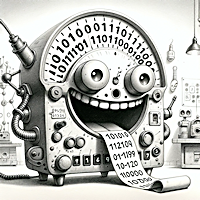Binary to Decimal

This Binary to Decimal Converter is a simple web tool that allows users to convert binary numbers (including fractional binary numbers) into their decimal equivalents. In binary, only two symbols represent all numerical values, typically 0 and 1. On the other hand, the decimal system uses ten symbols (0-9) to represent numerical values.
Binary to Decimal Converter
| Binary Input base2 | |
| Decimal Places # | |
Result: | |
|
Calculator
- enter a binary (base-2) number
- decimal precision, the number of digits after the decimal point in the result
Result
- the binary (base-2) converted to a decimal (base-10) number
Converting a binary number to decimal involves multiplying each digit of the binary number by powers of 2 and then summing up the results.
Start from the rightmost digit (the least significant bit).
Assign powers of 2 to each digit's position, starting from 0 for the rightmost digit and increasing by 1 for each position to the left.
Multiply each digit by 2 raised to the power of its position.
Sum up all the results to get the decimal equivalent.
Start from the rightmost digit (the least significant bit).
Assign powers of 2 to each digit's position, starting from 0 for the rightmost digit and increasing by 1 for each position to the left.
Multiply each digit by 2 raised to the power of its position.
Sum up all the results to get the decimal equivalent.
Example Conversion
Convert the binary number 101110 to decimal: Starting from the rightmost digit:
Starting from the rightmost digit: 1. 0 * 20 = 0 (least significant bit) 1 * 21 = 2 1 * 22 = 4 1 * 23 = 8 0 * 24 = 0 1 * 25 = 32 (most significant bit) Add the results together: 0 + 2 + 4 + 8 + 0 + 32 = 46
The binary number 101110 is equivalent to the decimal number 46.Convert the binary number 1101.1101 to decimal:
Convert binary number 1101.1101 to decimal: Separate the integer part from the fractional part: Integer part = 1101 Fractional part = 0.1101 Integer Part (1101): Start from the rightmost digit (the least significant bit) and move left. Multiply each digit by 2 raised to the power of its position, starting from 0 for the rightmost digit, and add up the results. 1*20+0*21+1*22+1*23 =1 + 0 + 4 + 8 =13 Binary 1101 is equivalent to decimal 13 Fractional Part (0.1101): Start from the leftmost digit (the most significant bit) and move right. Multiply each digit by 2 raised to the negative power of its position, starting from -1 for the leftmost digit, and add up the results. 1 * 2-1 + 1 * 2-2 + 0 * 2-3 + 1*2-4 = 0.5 + 0.25 + 0 + 0.0625 = 0.8125 Binary 0.1101 is equivalent to decimal 0.8125 Combine the Integer and Fractional Parts: Integer part = 13 Fractional part = 0.8125
The binary number 1101.1101 is equivalent to decimal 13.8125.